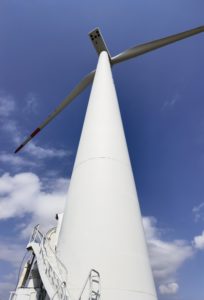Case study:
Cost-efficient and reliable pitch control and backup power for wind turbines with hybrid powercapacitors
 Wind turbines today are increasingly used to generate part of our electricity. Their operation however is subject to variable wind conditions and they also must operate in very cold to very warm weather conditions.
Wind turbines today are increasingly used to generate part of our electricity. Their operation however is subject to variable wind conditions and they also must operate in very cold to very warm weather conditions.
An important part of a wind turbine are the pitch controllers. These are used to continuously help in adjusting the blade’s angle to the wind variability but also to rotate the blades to a safe position in an emergency shut-down or when the wind becomes too fierce. This is often done in conjunction by using part of the generated electricity and a battery connected in parallel. The batteries are needed because the load is very variable and dynamic requiring high power peaks. This battery is also the back-up power supply if for some reason the main power is lost. Thus, it is important that the backup power supply is always available. Both ultracapacitors and lead-acid batteries were until now commonly used as energy storage devices for the pitch control system.
Lead-acid batteries have a limited life span and have a reduced capacity at low temperatures (40% capacity left at -20°C). Furthermore, the required power is a limiting factor for the batteries. The batteries need to be replaced approximately every 3 to 5 years after installation. Ultracapacitors on the other hand have a long-life span and don’t suffer from extreme temperature environments as much, but they have a low energy density (3-10Wh/kg). This results in heavy and expensive systems. A pitch backup power supply using batteries must have the capacity to perform three full load pitch adjustments. With electric double layer capacitors (EDLC’s) often only one can be performed, increasing the vulnerability of the system.
This paper will discuss the replacement of lead-acid batteries with carbon-based hybrid power capacitors on a wind turbine of Shanghai Electric. We also briefly discuss how they improve on the use of EDCL supercapacitors.
Read the white paper here:

Recent Comments